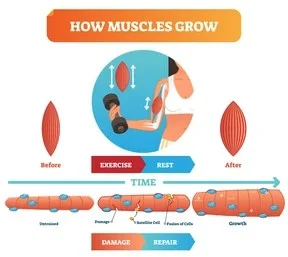The Science of Recovery: Unlock Your Gains with Evidence-Based Recovery
Did you know that the most critical part of building muscle happens outside the gym? Recovery is where strength and size truly develop, turning hard training into visible results. Let’s break down the science of recovery and how you can make it work for you.
1. Why Recovery is the Game-Changer
Recovery isn’t just rest—it’s an active process of repair and adaptation. According to the American College of Sports Medicine (ACSM), proper recovery improves muscle repair, reduces fatigue, and prevents overtraining syndrome.
💡 Key Insight: After an intense workout, your muscle protein synthesis spikes for up to 48 hours. This means what you do post-workout can make or break your gains!
2. Sleep: The Hidden Superpower
Sleep isn’t just “rest”—it’s where your muscles grow. During deep sleep, your body releases growth hormone, which accelerates tissue repair and muscle development. A 2018 study by Fullagar et al. found that athletes who slept less than 6 hours experienced impaired performance and slower recovery.🔑 How to Optimize:
- Aim for 7–9 hours of sleep each night.
- Create a sleep-friendly environment: blackout curtains, no screens before bed, and a consistent bedtime.
3. The Nutrition Connection
Your muscles are like sponges after training—ready to absorb nutrients and repair damage. Here’s what you need:
- Protein: Research from Phillips & Van Loon (2011) recommends consuming 20–40g of high-quality protein within 2 hours post-workout to maximize recovery.
- Carbs: Restore energy by consuming 1–1.5g of carbs per kg of body weight within the same window.
- Fats: While often overlooked, healthy fats support inflammation control and joint health.
💡 Quick Recovery Snack: Greek yogurt with honey and berries.
4. Active Recovery: Move to Heal
Active recovery isn’t about skipping the gym—it’s about moving smart. Studies like Ahmaidi et al. (1996) show that low-intensity activities (e.g., walking or yoga) improve blood flow and speed up the clearance of metabolic byproducts like lactate.
Try This:
- 15–20 minutes of brisk walking.
- Light stretching or foam rolling post-workout.
5. Recovery Myths, Debunked
- “No Pain, No Gain”: False. Persistent soreness may signal overtraining, not progress.
- “More Work = Better Results”: Wrong. Recovery ensures you can work harder over time.
- “Supplements Fix Everything”: Nope. Sleep and nutrition are irreplaceable foundations.
6. Track Your Recovery
Every body recovers differently, so it’s important to listen to your own. Signs you might need more recovery include:
- Lingering soreness beyond 48 hours.
- Reduced workout performance.
- Increased fatigue or irritability.
💡 Pro Tip: Use a fitness tracker to monitor your heart rate variability (HRV). Lower HRV might indicate you need extra rest.
Closing Thoughts
Recovery is the secret ingredient to long-lasting progress. By prioritizing better sleep, smarter nutrition, and tuning in to what your body needs, you're laying the foundation for sustained success.References
Fullagar, H. H. K., et al. (2018). Sleep and Athletic Performance: The Influence of Sleep on Exercise Performance, Training, and Recovery. Sports Medicine, 48(3), 441–453. Read the study
Phillips, S. M., & Van Loon, L. J. C. (2011). Dietary Protein for Athletes: From Requirements to Optimal Adaptation. Sports Medicine, 41(5), 353–368. Read the study
Ahmaidi, S., et al. (1996). Effects of Active Recovery on Lactate Clearance. European Journal of Applied Physiology, 73(3), 208–212. Read the study
Chtourou, H., & Souissi, N. (2012). The Effect of Recovery Strategies on Exercise Performance: A Review. Journal of Strength and Conditioning Research, 26(2), 533–542. Read the study
Ziegler, P. R., & Tipton, K. D. (2015). Nutritional Strategies to Promote Muscle Hypertrophy. Journal of the International Society of Sports Nutrition, 12(1), 1-10. Read the study
O’Connor, P. L., et al. (2009). The Influence of Stretching on Muscle Soreness and Recovery Following Exercise. Medicine and Science in Sports and Exercise, 41(3), 539-545. Read the study
Roig, M., et al. (2009). The Effects of Sleep Extension on the Performance of Athletes: A Systematic Review. Sleep Medicine Reviews, 13(6), 297-305. Read the study







